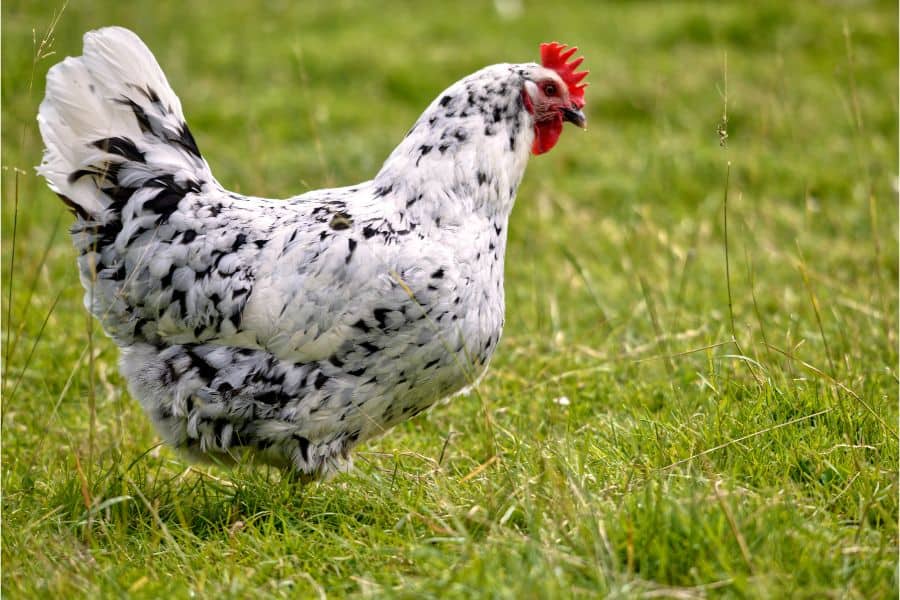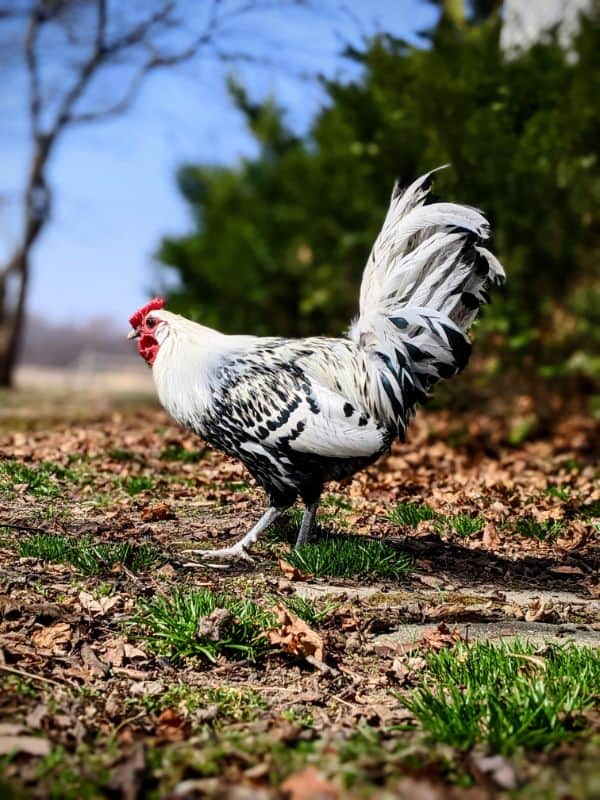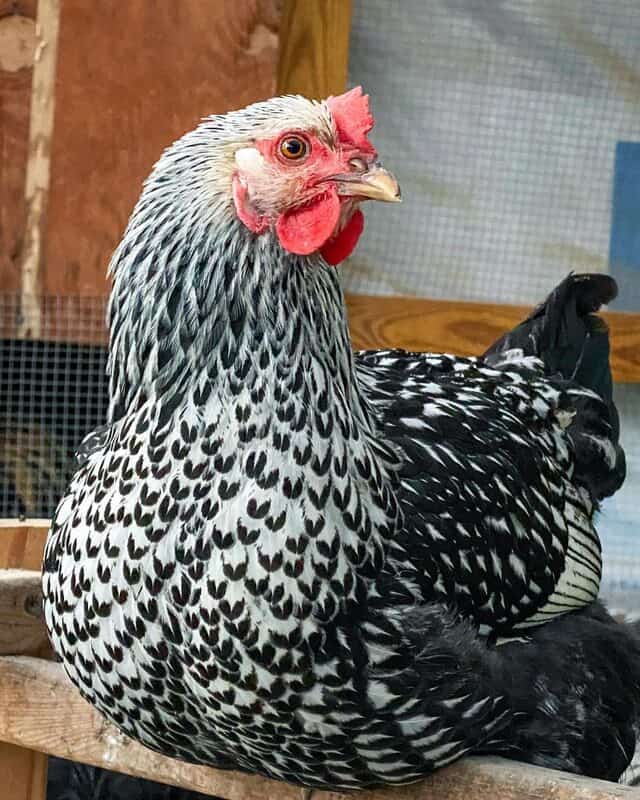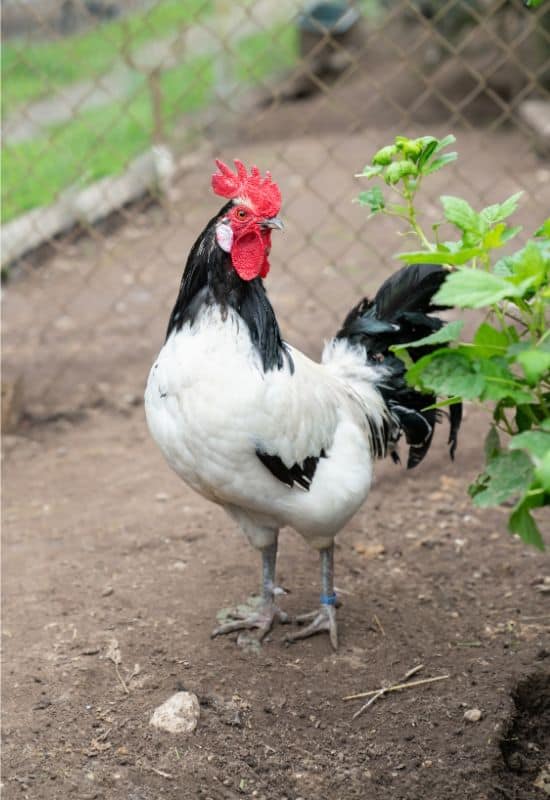Did you know that black, white, and gold (red) feathering colors are considered the three basic colors in chickens? Yes, there is nothing more that goes into making the many amazing, including white and black patterned, chickens we love today.
From the classic black & white Plymouth Rock to the laced Wyandotte and the enigmatic Lakenvelder, black and white patterns have stood the test of time as some of the most beloved colors on chickens.
It also helps matters that these are among the most common coloration you can ever find in many breeds, hybrids, and bantams.
Read on to dive into the many attractive patterns that make up white and black chickens. Get to learn how to differentiate these patterned birds, learn their separate unique characteristics, and easily decide which ones fit your particular needs.
Black and White Patterns You Can Find On Chickens
As you may well know, black and white chickens do not come in the same color variation, pattern, or shade. Depending on many factors including genetics, environmental effects, and cross-breeding, chickens exhibit six different pattern types of the black and white color scheme.
Knowing which pattern is most appealing to you will make it much easier in picking the perfect color combination. It will also make it much quicker to distinguish the black and white breeds from one another and also help identify sex differences in some breeds.
1. Barred Pattern
In the barred pattern, the chicken’s feathers have alternating bands/stripes of black and white or dark and light coloration. The bars are usually parallel to each other, running across the width of the feathers. However, the bands/stripes might also be irregular with no easily discernable patterns.
This pattern creates a visually appealing appearance and is commonly found in chicken breeds like the Plymouth Rock.
2. Laced Pattern
The laced pattern is characterized by a delicate outline of black color around the edges of each feather, giving a lacy or frosted appearance. The center of the feather is usually white or a lighter color, while the edges have a solid black border.
The laced pattern is often found in breeds like the Wyandotte.
3. Mottled Pattern
Chickens with mottled patterns have feathers with a plain white background but with irregular black feather edges. Essentially, mottled chickens are black chickens with white tipped feathers.
An example of such chicken is the Mottled Ancona.
4. Spangled Pattern
Spangled pattern chickens have small, round or oval-shaped black spots on a white or light-colored background. The spots appear as such because the feathers lack pigmentation at these regions, thereby creating black spots all over the body.
These spots are evenly distributed across the body and wings, creating a distinctive and evenly speckled appearance.
The Hamburg breed is an example of a chicken that displays the spangled pattern.
5. Penciled Pattern
The penciled pattern is characterized by thin, dark lines or “penciling” that run down the length of each feather. These lines are usually black and give the appearance of delicate, fine markings on a lighter background.
Breeds like the Egyptian Fayoumi and the Silver Penciled Plymouth Rock exhibit this pattern.
6. Columbian Pattern
The Columbian pattern consists of solid black coloration on the neck, tail, and wing feathers, while the body feathers are primarily white. This creates a contrasting appearance, and the overall effect as a result of black gene restriction that prevents the black color from gaining dominance on any other parts of the chicken.
The Columbian Wyandotte is an example of a breed that displays this pattern.
Top 13 Black And White Chicken Breeds
1. Barred Plymouth Rock Chicken
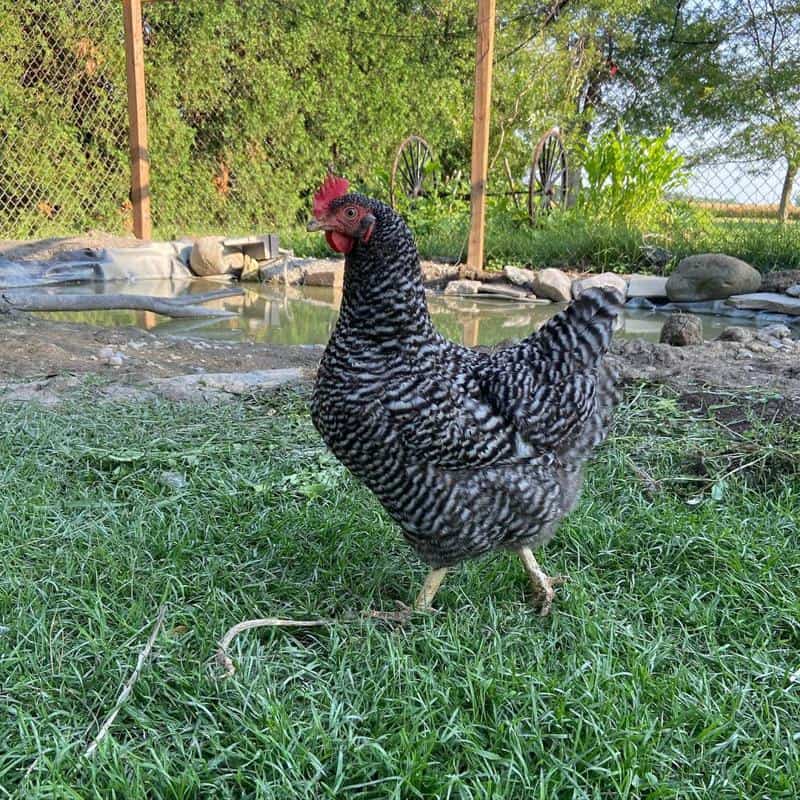
- Country of Origin: New England, United States
- Primary Use: Meat and Eggs
- Average Weight (lbs.): Roosters: 8 – 9.5, Hens: 6 – 7.5
- Color Patterns: Barred & Silver Penciled
- Egg Production Per Year: 200-280
- Egg Color & Weight: brown/tinted Medium to Large Eggs
- Temperament: friendly, docile, hardy
No other white and black chicken screams classic beauty and timeless appeal like the Plymouth Rock.
The Plymouth Rock is a classic example of the barred black & white pattern, with striking black and white striped feathers. There is also a newer & lovelier silver penciled variety, though not as common.
In terms of size, Plymouth Rock is considered to be a medium to large breed. With a broad and well-rounded body, these chickens have a strong and robust build, making them quite hardy and able to withstand various weather conditions.
The chicken is known for its calm temperament, making it an excellent backyard bird. These breeds are also dependable layers, producing lots of eggs every year enough for a large-scale production farm guaranteed to make some profits.
With their American origin and historical significance, Plymouth Rocks are a cherished part of poultry heritage. Developed in New England during the mid-19th century, it quickly gained popularity for its attractive appearance and utility.
This Black & White Barred Plymouth Rock variety was one of the earliest color variants to be recognized, making it a true pioneer among Plymouth Rock breeds. It was also a contributor to the development of broiler chickens in America for industrial purposes.
Plymouth Rock’s widespread popularity has contributed to its availability, making it relatively easy to find and acquire. Their historical significance in America and their role in the development of poultry farming ensure they remain a cherished part of chicken-keeping heritage.
2. Brahma
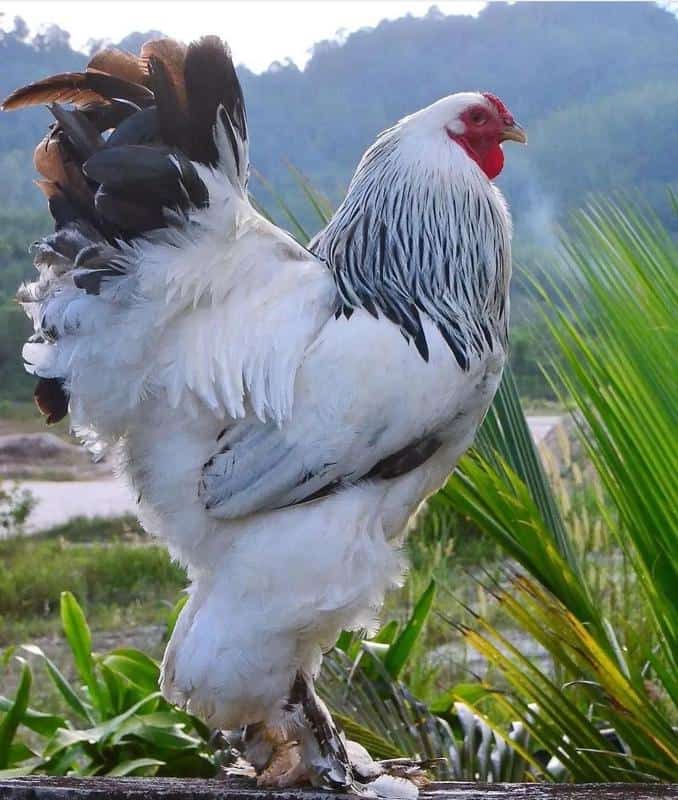
- Country of Origin: United States
- Primary Use: Egg & Meat, Exhibition
- Average Weight (lbs.): Rooster: 9 – 11, Hen: 6.5 – 8.5
- Color Pattern: Spotted
- Egg Production Per Year: 150 – 200
- Egg Color & Weight: medium -large brown eggs
- Temperament: Gentle, docile, hardy
This is an American-bred chicken that was imported from the Chinese port in Shanghai back in the 19th Century. Since the 1850s, it became the United States’ main source of chicken meat up to the 1930s due to its massive giant size.
Size-wise, the Dark Brahma is quite an impressive fowl. It stands tall with a broad, muscular build that gives it an imposing presence in the chicken coop. Don’t let its size intimidate you, though, as beneath that stately exterior lies a friendly and gentle nature.
The majestic Brahma stands out with its stunning black and white spotted plumage.
Although they have a slower growth rate, they are excellent layers. These birds are known for laying generously-sized brown eggs that are both nutritious and delicious. Plus, their eggs have a reputation for being especially rich and flavorful, making them a prized choice for the discerning egg connoisseur.
3. Cuckoo Marans
- Country of Origin: France
- Primary Use: Egg & Meat
- Average Weight (lbs.): Roosters: 7 – 9, Hens: 6 – 7.5
- Color Pattern: Barred
- Egg Production Per Year: 150-200
- Egg Color & Weight: large, dark chocolate-brown eggs
- Temperament: calm, friendly
Displaying a beautiful speckled appearance, the Cuckoo Marans impress with their unique black and white barred pattern.
This attractive coloration, known as “cuckoo,” creates a beautiful mosaic effect on their feathers, giving them an air of elegance. The contrast between the dark and light spots is truly captivating and sets them apart from other breeds.
Cuckoo Marans chickens are considered medium to large birds. They have a sturdy and well-built physique, showcasing strong legs and a broad chest. Their bodies are compact, making them agile and capable foragers.
Renowned for their friendly nature, they are a joy to raise. They tend to be docile and social, making them great companions for families and small-scale farmers alike. While individual personalities can vary, they are generally calm and easy to handle.
4. Silver Spangled Hamburg
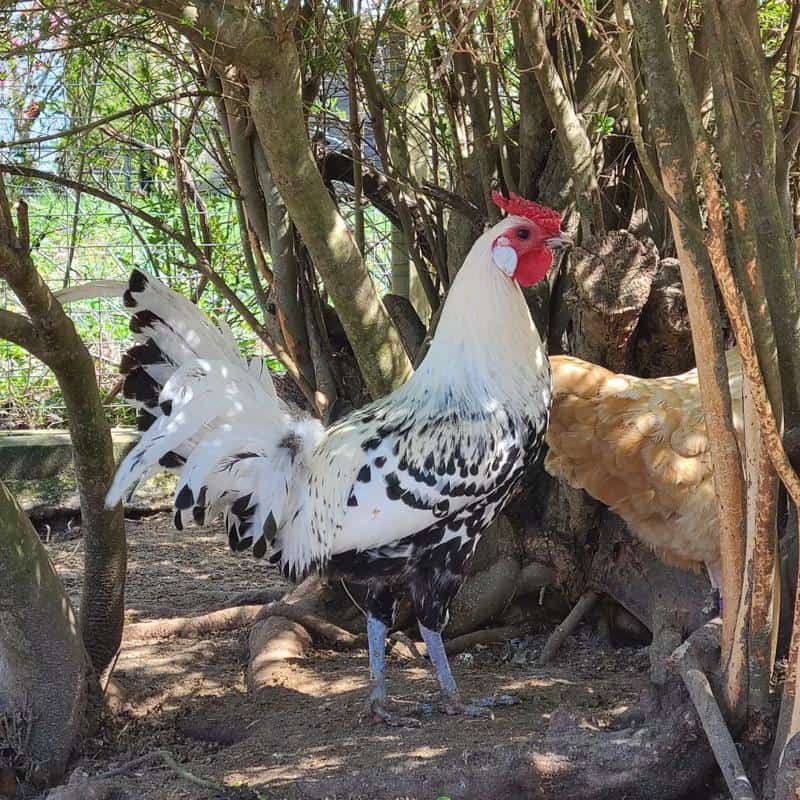
- Country of Origin: Germany
- Primary Use: Eggs and Ornamental, Exhibition
- Average Weight (lbs.): Roosters: 4 – 5, Hens: 3.5 – 4
- Color Pattern: Laced and Spangled
- Egg Production Per Year: 150-200
- Egg Color & Weight: small white eggs
- Temperament: Active, Independent, Calm, friendly
The Hamburg chicken is either spangled or laced. The silver-spangled Hamburg is among the most attractive featuring eye-catching white feathers adorned with small, intricate black spots.
The black spots form a spangled pattern, which gives them their captivating appearance. They’re like little stars strutting around the backyard!
These active and independent chickens are excellent foragers, making them perfect for free-range environments. They love to explore their surroundings and can be quite adventurous. Expect to see them hopping around and foraging for tasty treats all day long. Due to their lively nature, they may not be the cuddliest of breeds, but they can still be friendly and sociable if handled and raised with care.
Silver Spangled Hamburg got a compact and sleek body structure, making them agile and excellent flyers. Their light builds and graceful movements add to their overall charm.
5. Dominique
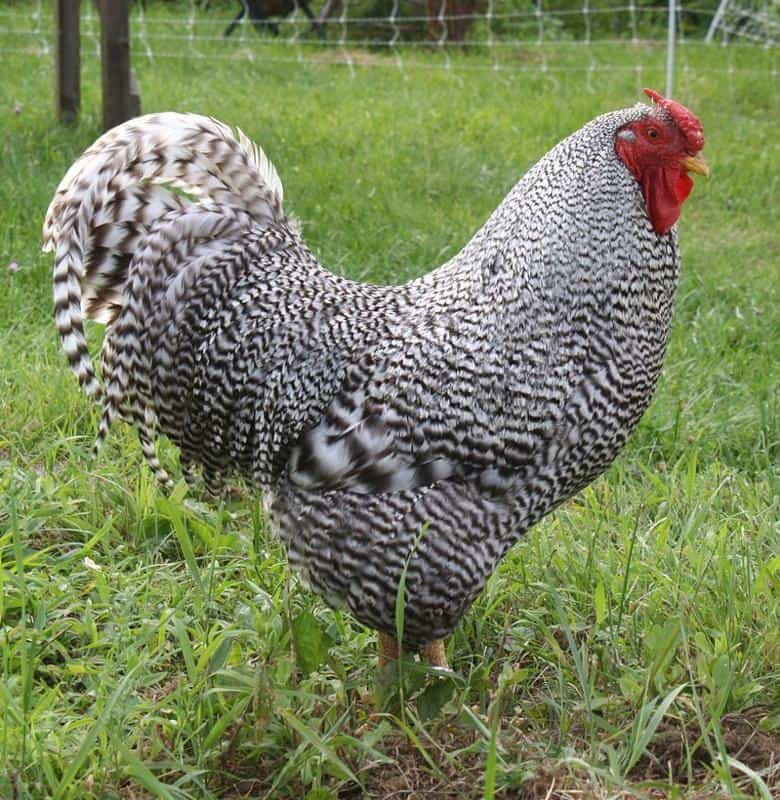
- Country of Origin: United States
- Primary Use: Eggs and Meat
- Average Weight (lbs.): Roosters: 7+, Hens: 5+
- Color Pattern: Barred
- Egg Production Per Year: 230-275
- Egg Color & Weight: medium- Large brown eggs
- Temperament: Hardy and Calm
The Dominique, also known as the “Pilgrim Fowl,” boasts a distinctive black and white striped plumage, showcasing its barred pattern. Known for their friendly and calm demeanor, Dominiques are easy to handle.
These dual-purpose chickens are reliable consistent production layers, making them a practical choice for small-scale farming.
They are considered contenders for the title of being America’s oldest breed since they were bred from chickens brought to America by the Southern England colonists. They have earned their place in poultry heritage due to their hardiness, versatility, and adaptability to various climates and environments.
6. Black Laced Silver Wyandotte
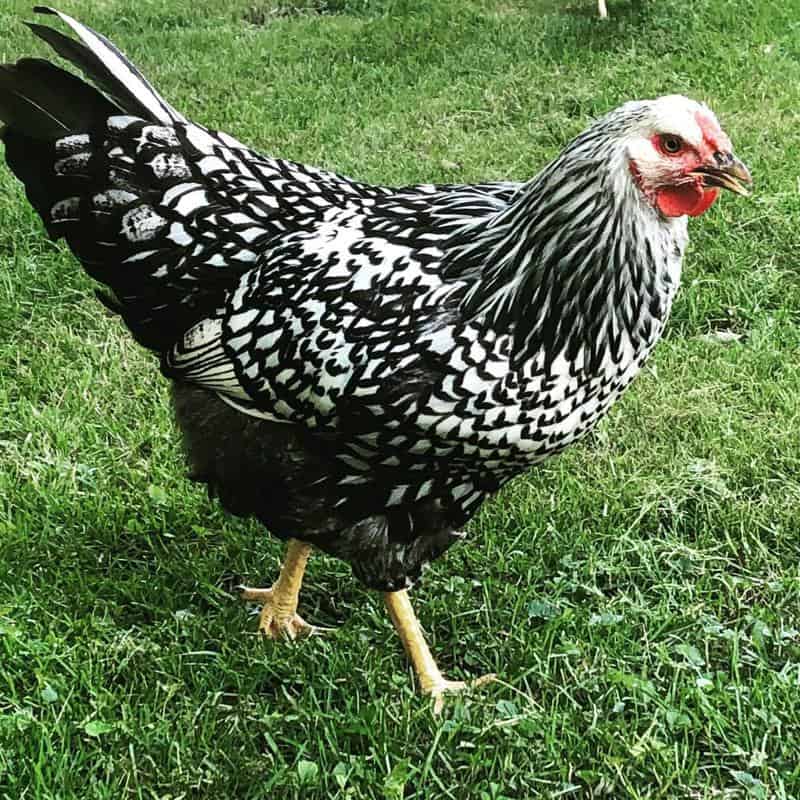
- Country of Origin: United States
- Primary Use: Egg & Meat
- Average Weight (lbs.): Roosters: 7 – 9, Hens: 6 – 7.5
- Color Pattern: Laced
- Egg Production Per Year: 180-260
- Egg Color & Weight: medium light brown eggs
- Temperament: Friendly, Calm, Hardy
Not to be confused with the Columbian Wyandotte, the Black Laced Silver Wyandotte is a common variant of the Wyandotte family.
It is an elegant breed with exquisite black lacing on silver-white feathers. To achieve this striking pattern, breeders typically cross a Silver Laced Wyandotte with a black breed, often a Black Cochin or a Black Langshan.
The feathers are well-rounded and smooth, contributing to Wyandotte’s overall elegant appearance. With its upright posture and balanced body shape, this breed has a robust and appealing silhouette.
Their friendly nature makes them ideal for family flocks.
7. Columbian Wyandotte
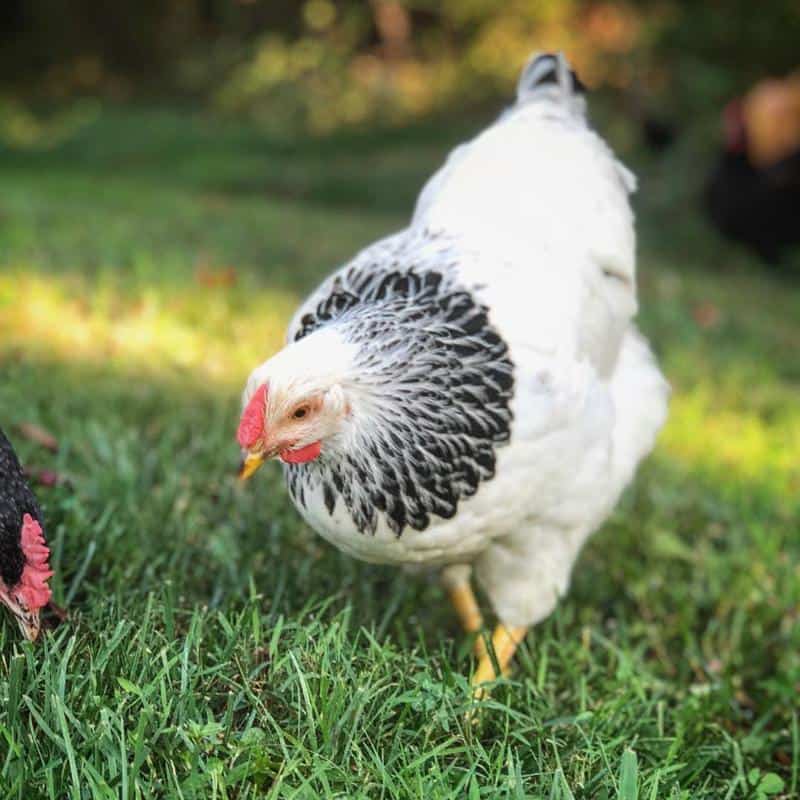
- Country of Origin: United States
- Primary Use: Eggs & Meat
- Average Weight (lbs.): Roosters: 8+, Hens: 6.5+
- Color Pattern: Columbian
- Egg Production Per Year: 200-240
- Egg Color & Weight: medium-large brown eggs
- Temperament: friendly, docile, calm
Featuring a rice comb and clean legs, the Columbian Wyandotte chickens exhibit a stunning contrast that is one of a kind in the Wyandotte family. It is a product of Barred Plymouth Rock and the White Wyandotte, giving rise to a high egg layer fit for large-scale farming.
Also known as the Silver Columbian Chickens, these Wyandotte chickens have solid black coloration on their neck, tail, and wings against a snowy white body.
The Columbian Wyandotte holds a special place in the hearts of poultry enthusiasts. It is a hardy breed that can survive even the coldest of months with its thick plumage, and they are foraging experts able to easily search for food in any environment.
8. Light Sussex
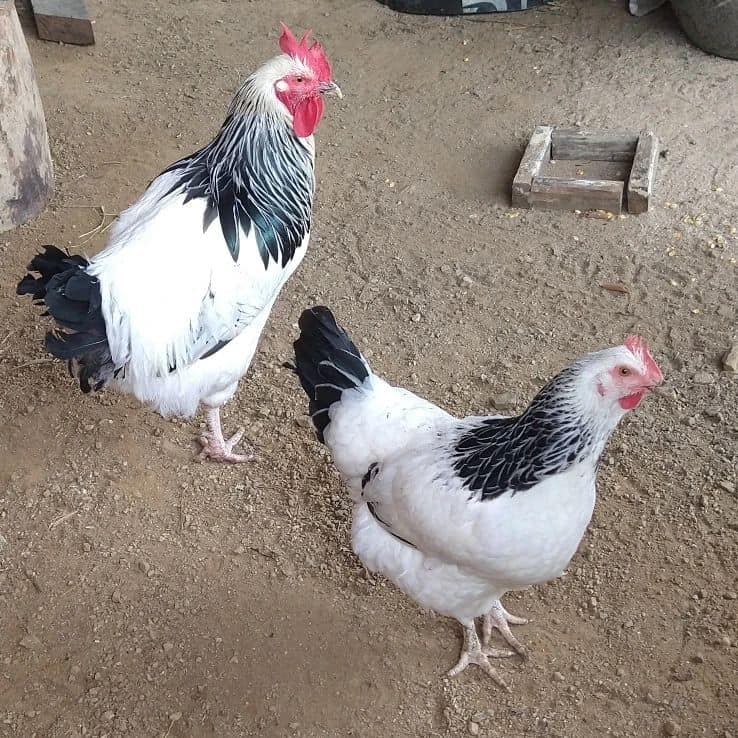
- Country of Origin: United Kingdom
- Primary Use: Meat, Eggs, Exhibition
- Average Weight (lbs.): Roosters: 8+, Hens: 6.5+
- Color Pattern: Columbian
- Egg Production Per Year: 250-300
- Egg Color & Weight: Large brown eggs
- Temperament: Docile and Calm
The Light Sussex, featuring a splendid contrast of pure white and black tail feathers, is a striking sight in any flock. It is a white skin and shank chicken with a single comb and Columbian pattern.
They originally came from England in the 1900s and their meat supply made them popular in other regions like Canada.
With a history dating back to the 19th century in England, the Light Sussex holds an essential place in poultry heritage. It is known for its high egg production of over 250 eggs annually, making a flock of Light Suzzex a practical choice for those looking to maintain a steady supply of fresh and delicious eggs.
9. Mottled Ancona
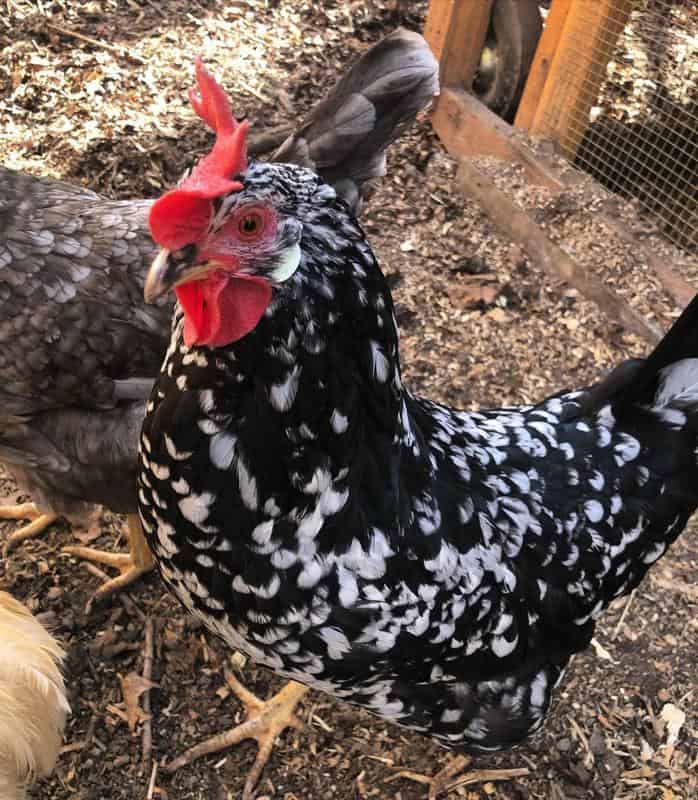
- Country of Origin: Italy
- Primary Use: Eggs
- Average Weight (lbs.): Roosters: 6+, Hens: 4+
- Color Pattern: Mottled
- Egg Production Per Year: 250-280
- Egg Color & Weight: Large White Eggs
- Temperament: Alert, Active, Friendly
With their captivating mottled black and white plumage, the Mottled Ancona is an eye-catcher. Their feathers showcase a beautiful mottled pattern, featuring irregular specks of black scattered on a crisp white background.
These active and alert chickens are excellent foragers and adaptable to various environments.
Originating in Ancona, Italy, the Mottled Anconas are excellent egg layers but are not good for meat-keeping due to their small sizes. However, they are great for keeping even if you aren’t looking to produce them due to their personality.
Their curiosity and playfulness will keep you entertained, and they’ll quickly become part of the family with their friendly and approachable demeanor.
10. Lakenvelder
- Country of Origin: Netherlands & Germany Border
- Primary Use: Ornamental
- Average Weight (lbs.): Roosters: 5 – 6, Hens: 4 -5
- Color Pattern: Columbian
- Egg Production Per Year: 150-200
- Egg Color & Weight:
- Temperament: Active, Social
In Dutch, the name Lakenveider translates to “white spread over a black field”
Known for their striking “V” shaped black and white pattern on their feathers, the Lakenvelder has an out-of-this-world feathering – which is why they are the rarest black and white chickens on this list.
The bird’s body is predominantly white, with crisp, well-defined black markings on its neck, back, wings, and tail. The black coloration forms a “V” pattern on the back, creating a stunning contrast against the white base.
The breed has a moderately-sized single comb, which can vary slightly depending on the individual bird. Its wattles and earlobes are small and are typically red. The Lakenvelder’s eyes are bright and expressive, adding to its overall charm.
They are enjoyable companions with a medium build that gives them a balanced and graceful appearance.
The Lakenvelder chicken was kept as a dual-purpose breed, valued for both its egg-laying capabilities and meat. However, over time, it has predominantly become a show and exhibition bird due to its eye-catching coloration and distinct appearance.
11. California Gray
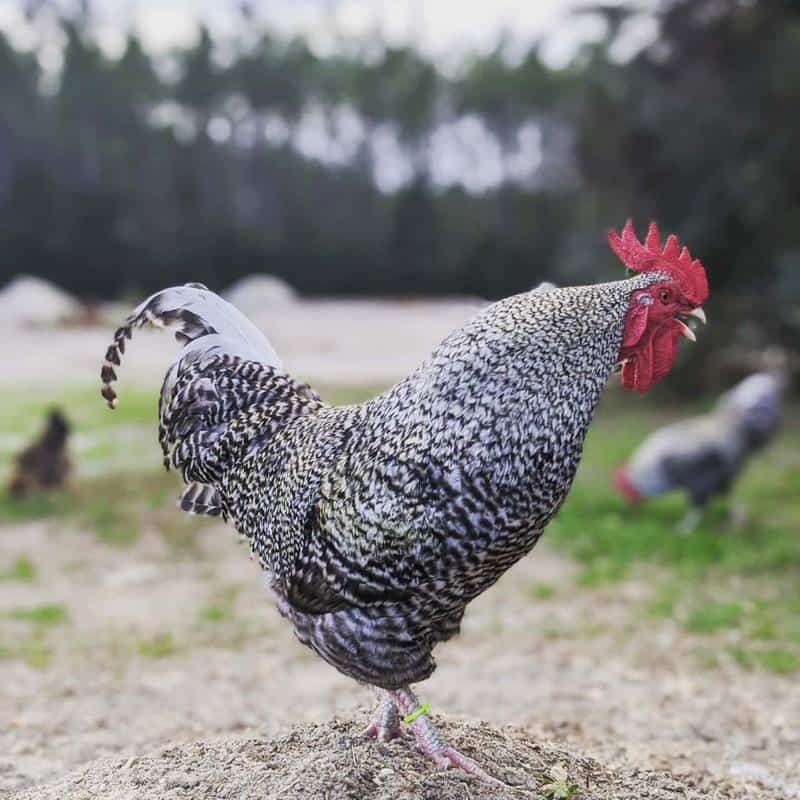
- Country of Origin: California, USA
- Primary Use: Egg and Meat
- Average Weight (lbs.):
- Color Pattern: Laced, Barred
- Egg Production Per Year: 250-300
- Egg Color & Weight: Light Brown Medium to Large Eggs
- Temperament: calm and friendly
Developed in the United States during the mid-20th century, California Gray is a result of crossing two well-known and respected breeds – the California White and the Barred Plymouth Rock.
The savvy breeders aimed to combine the best traits of these two chickens to create a bird that excels in both egg production and meat quality.
The California Gray feathers exhibit a laced or barred pattern, creating a stunning overall appearance. The black and white plumage is evenly distributed across their body, giving them a balanced and harmonious look.
Additionally, their legs and beak are a vibrant yellow color, adding a splash of brightness to their elegant appearance.
Their friendly nature makes them suitable for families.
12. Silver Laced Polish Chicken
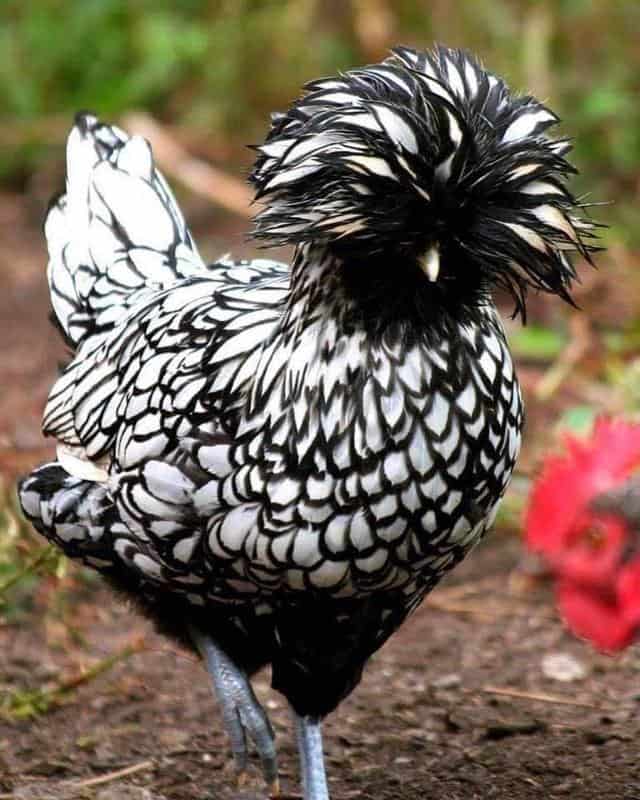
- Country of Origin: Europe
- Primary Use: Eggs & Ornamental
- Average Weight (lbs.): Roosters: 6+, Hens: 5.5+
- Color Pattern: Laced
- Egg Production Per Year: 150-200
- Egg Color & Weight: Small-Medium White Eggs
- Temperament: Friendly, docile, calm
The Silver Laced Polish Chicken, as the name suggests, traces its roots back to Poland, where it was first developed in the 16th century. These lovely birds were brought to England in the 18th century and eventually made their way to the United States, gaining popularity for their striking appearance and gentle demeanor.
The chicken features silver-white feathers adorned with striking black lacing. The lacing forms a beautiful contrast, creating a lace-like pattern across the bird’s body. The lacing is most prominent on the neck and back feathers, while the wings and tail also feature this eye-catching arrangement.
They are friendly and non-aggressive birds, making them ideal for families.
13. Egyptian Fayoumi
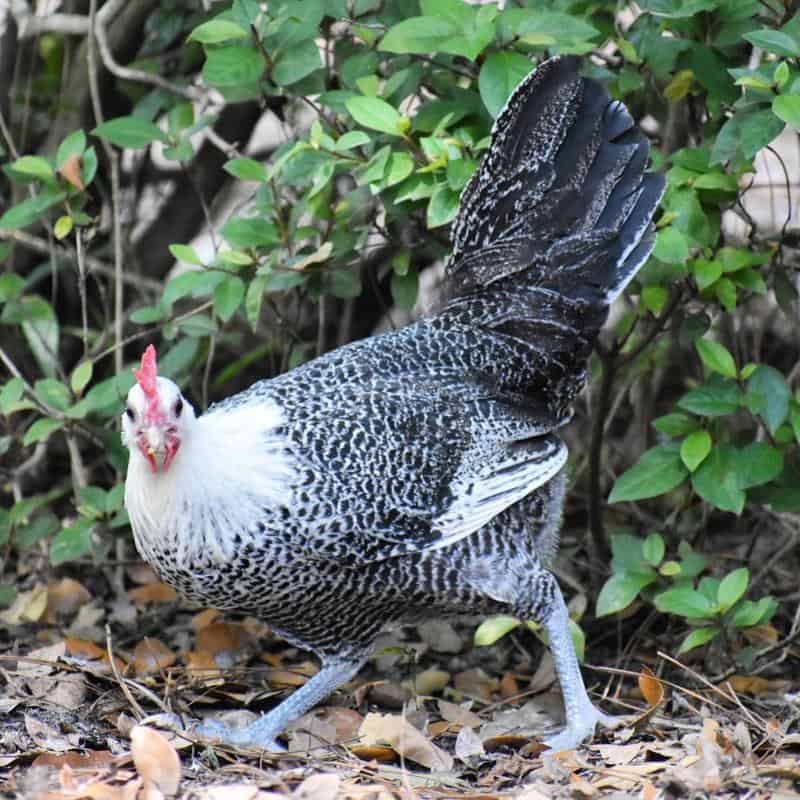
- Country of Origin: Egypt
- Primary Use: Eggs & Ornamental/shows
- Average Weight (lbs.): Roosters: 4 – 5, Hens: 3 – 4
- Color Pattern: Penciled
- Egg Production Per Year: 150-180
- Egg Color & Weight: Small Cream/White Eggs
- Temperament: Athletic, Active, Hardy
The Egyptian Fayoumi is a rare and exotic breed that was first seen in the United States in the 1940s and England in the 1980s.
It sports a striking black and white speckled pattern on their feathers, making them stand out in any flock. This dashing look helps them blend into their natural surroundings, which probably came in handy when they were roaming the Egyptian landscapes in ancient times.
These chickens are hardy and independent, thriving in free-range environments. However, it is crucial to note that the Fayoumis thrive in hot regions but have a harder time adjusting to colder temperatures.
While they are not the best layers, their fantastically tasty eggs with low cholesterol make them a prized addition to any flock.
Also Read:
Conclusion
White and black chickens, with their diverse patterns and unique featuring make up a big chunk of the attractive chicken list.
From the friendly Plymouth Rock, to the rare Lakenvelder, Italian Mottle Ancona, and the exotic Egyptian Fayoumi, each breed offers its own set of traits, making them suitable for various preferences and needs.
Whether you seek a prolific layer, a gentle companion, or a rare gem for exhibition, these breeds are sure to leave you enchanted with their beauty and charm.
